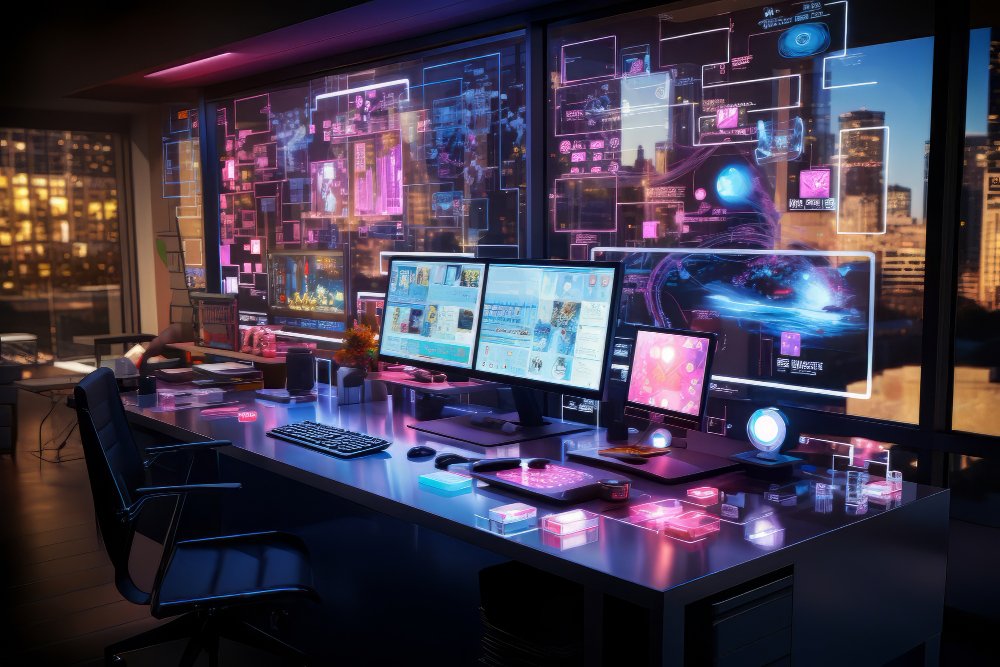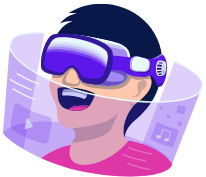The rise of AR/VR tech presents the virtual desktop/multi-monitor concept almost completely free from the physical context, which breaks classical setups full stop. So, whether you are using Meta Quest or Apple Vision Pro; virtual desktop environment with multiple monitors gives a dynamic and efficient workspace especially for AR/VR solutions. In this article we will show you how to use virtual desktop with multiple displays, what it gives us and takes away from us as well as the tools or applications that can be useful to increase our productivity.
Table of Contents
Understanding Virtual Desktops and Multiple Monitors
Users can simulate a computer place on desk with AR/VR tech. Users can use multiple monitors in this virtual space that is detached from the physical limitations of their actual hardware. This setup is best suited for professionals who need a lot of screen space to multitask, i.e., developers, designers and analysts.
AR/VR Devices for Virtual Desktops
1. Meta Quest
One of the most popular VR headsets, Meta Quest (formerly Oculus Quest) allows virtual desktop applications. For example, Meta Quest offers Workspace Infinite – a virtual office where users can have several monitors set up to switch frequently and be more productive on tasks. It also has one of the most capable displays and interface a virtual desktop setup can ask for.
2. Apple Vision Pro
Another great virtual desktop tool is Apple Vision Pro. Vision ProThis ultra-immersive virtual desktop is used for its unparalleled quality of the display, as well as integration with Apple’s ecosystem. AR capabilities of the device allow for a much more natural and intuitive way to work with your virtual monitors.
3. AR Glasses
Augmented Reality, for example via Microsoft HoloLens or Google Glass which mix virtual overlay elements into the real world. The 12 virtual monitors can be arranged around the user in an actual space, making it a more interactive and how should I say versatile workspace.
Benefits of Virtual Desktop Multiple Monitors

1. Increased Productivity
Users with more virtual monitors can then manage their task much easily. As an example, one screen may be set for email while the other displaying a web browser and another still showing a particular application. It means no need of switching between windows and applications hence more productive.
2. Space Saving
Save your valuable desk space, no physical screens needed with virtual monitors This is especially beneficial for those who are space constrained or like to have their table clean.
3. Portability
Your entire workspace is portable with virtual desktops. Great for traveling remote workers, or digital nomads as well.
4. Enhanced Immersion
AR/VR- is increasingly more all-encompassing making it easier for users to focus on their assignment. The ability to manipulate virtual displays with everyday gestures goes a long way toward making sure that honey-moon period never ends.
Disadvantages of Virtual Desktop Multiple Monitors
1. Initial Setup and Learning Curve
Now, creating a virtual desktop with multiple monitors can become cumbersome and you may also have to undergo learning curve. This technology needs to be backed up by the device an software but users do need some learning curve to start using it.
2. Eye Strain and Fatigue
The basic issue is as long-term use of the AR/VR glasses would lead to eye fatigue. Need for users to breaks and some guidelines should be followed but at the same time best practices reduce eye strain.
3. Cost
Quality AR/VR devices can be quite pricey. What is important for end-users, however, is determining if the cost outweighs the benefit in their very own clinical scenario and environmental context.
Tools and Applications for Virtual Desktop Multiple Monitors
1. Virtual Desktop App
Virtual Desktop works on at least a few VR headsets like the Meta Quest, and HTC Vive. It enables users to stream their PC or Mac into a virtual environment consisting of multiple monitor entities. It offers high-quality visuals with low-latency, making it a favorite among professionals.It is most popular app for the virtual monitor.
2. Immersed VR
One such application is Immersed VR, which allows for multiple virtual monitors in a VR environment. It provides functionalities like screen sharing, workspaces for teamwork and layouts of the monitors which can be customized. This virtual reality app works with a variety of VR headsets such as Oculus and HTC Vive.
3. SpaceTop
SpaceTop having a range of functions – from tilt based interaction to full 3D object manipulation, is an extremely unique AR desktop platform that marries physical & virtual elements into one input/output. This feature lets users place multiple virtual monitors on real walls, making the boundary between physical and virtual worlds nearly invisible. SpaceTop is ideal for a user who wants to experience mixed reality.
Tips for Optimizing Virtual Desktop Multiple Monitors
- Adjust Display Settings: You can adjust virtual monitor properties like resolution, brightness and contrast parameters to alleviate eye strain or enhance visual clarity.
- Use Ergonomic Furniture: Your physical workspace should be ergonomically designed to avoid failing after several hours of AR/VR device use.
- Take Regular Breaks: Every 20 minutes, look at least 20 feet away from a computer screen for more than 20 seconds to avoid eye fatigue.
- Organize Your Workspace: Order the virtual monitors following your workflow. Streamline; organize tasks and group them together.
- Stay Updated: You need to Take care of the minimal requirements – keep your hardware and software updated for new features, fixes, etc.
Sum up on Virtual Desktop Multiple Monitors
Multiple monitor virtual desktops give you a new way to boost productivity, save space and have an immersive work environment. AR/VR mixed with multi-monitor displays – the best of both worlds without physical limitations. For Meta Quest, Apple Vision Pro and some AR Glass you could build anything from a conducive layer to design your office or ideal projects it really knows no bounds. But the initial setup, learning curve and eye fatigue must be taken into account before venturing anywhere near this tech. If you fine-tune the experience with the right tools and practices, virtual desktops can really change how you work – simply by changing where all your digital content lives.
FAQs
1. What are the best applications for creating virtual desktops with multiple monitors?
Notable apps include Virtual Desktop, Immersed VR and SpaceTop. The apps come with unique sets of features to increase productivity and make virtual desktops nearly indistinguishable from the real ones.
2. How can I reduce eye strain while using virtual desktops?
Change the settings of your screen, take breaks often and put a lot more effort into building an ergonomic environment within which to work physically. Also, following the 20-20-20 rule can help reduce discomfort.
3. Are virtual desktops with multiple monitors suitable for all professions?
Virtual desktops can be useful for many professions, but developers, designers and analysts will find them especially productive since they require a lot of screen real estate to work in parallel.
4. What are the cost considerations for setting up a virtual desktop with multiple monitors?
There is a cost to deploying virtual desktop – this includes the actual price of AR/VR devices as well software applications that may be needed. They can also cost you a pretty penny, so it is worth considering the potential benefits weighed against price.
5. Can I use virtual desktops with multiple monitors for gaming?
Virtual desktops work with full gaming. These are experience devices that enable gamers to control aspects of their gameplay on different augmented reality screens.

